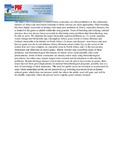| dc.description.abstract | The input costs of pesticides to control biotic constraints are often prohibitive to the subsistence farmers of Africa and seed based solutions to biotic stresses are more appropriate. Plant breeding has been highly successful in dealing with many pest problems in Africa, especially diseases, but is limited to the genes available within the crop genome. Years of breeding and studying cultural practices have not always been successful in alleviating many problems that biotechnology may be able to solve. We pinpoint the major intractable regional problems as: (1) weeds: parasitic weeds (Striga and Orobanche spp.) throughout Africa; grass weeds of wheat (Bromus and Lolium) intractable to herbicides in North Africa; (2) insect and diseases: stem borers and post-harvest grain weevils in sub-Saharan Africa; Bemesia tabaci (white fly) as the vector of the tomato leaf curl virus complex on vegetable crops in North Africa; and (3) the mycotoxins: fumonisins and aflatoxins in stored grains. Abiotic stresses may exacerbate many of these problems, and biotechnological alleviations of abiotic stress could partially allay some predicaments. Some of these constraints are already under study using biotechnological procedures, but others may require longer-term research and development to alleviate the problems. Despite the huge impacts of post-harvest weevils and of mycotoxins in grains, these issues had not been given high priority in national biotechnological programs, possibly due to a lack of knowledge of their immensity. The need for public sector involvement is accentuated for cases where immediate profits are not perceived (e.g. lowering mycotoxin levels in farmer utilized grain, which does not increase yield) but where the public weal will gain, and will be invaluable, especially where the private sector supplies genes already isolated. | en |

